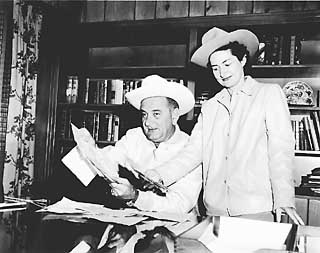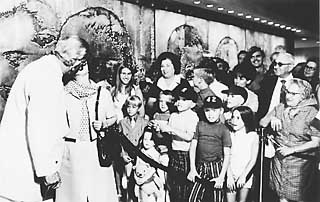https://www.austinchronicle.com/books/1999-08-20/522574/
Steel Magnolia
By Clay Smith, August 20, 1999, Books
|
Senator and Mrs. Johnson receive congratulations on November 16, 1959, their 35th wedding anniversary |
"Biographers are fixated on their hero in a quite particular way," Freud writes in "Leonardo da Vinci and a Memory of His Childhood," and Russell's biography is a quite particular one. The revelation Russell unearths from Lady Bird's cousin, so indicative of the pastoral, savage world that greeted Lady Bird in Karnack, in East Texas, at her birth in 1912, is one of many in this engrossing, occasionally lyrical biography. But it appears in chapter three. Chapter one, where we might expect to find the provenance of a nickname bestowed at age two, begins, tellingly, this way: "Lady Bird Taylor's life with Lyndon Johnson began with an ultimatum. 'Let's get married,' an overwrought twenty-six-year-old Lyndon wrote her from Washington shortly after the two met on a date in Austin on August 1, 1934. 'If you say no, it just proves that you don't love me enough to dare to marry me. We either do it now, or we never will.'"
Russell has said that her biography is about "the cost of marriage." It is also one feminist, the author, peering through the considerable strength of her microscope at a woman, a famous woman, who is not a feminist. Lady Bird often echoes the precision, but not the sterility, of an anthropological treatise on the well-heeled, well-mannered Southern lady and the old Southern way of life. Russell's description of Lady Bird's neurasthenic aunt Effie Patillo is proof that Tennessee Williams took from real life: Aunt Effie was "so gentle in spirit that she wouldn't crush a violet or kill a fly, but at the same time so infirm of body that she spent her evenings sipping medicine from small brown bottles to quell the pain of migraines and ulcers." Every day, Lady Bird's mother, Minnie Taylor, placed veils around her head. "She tied one scarf tightly around her forehead," Russell explains, "then veiled herself with additional scarves to diffuse the light, which she found painful. The Black people in Karnack spoke with fear about 'Miss Minnie's skullcaps.' Even now, more than eighty years after her death, they remember her as if she were an apparition." At Brick House, the 10-room, two-story antebellum home in Karnack where Lady Bird grew up, the ghost of 19-year-old Eunice Andrews, the daughter of Brick House's original owner, Confederate colonel Milt Andrews, inhabits the rear bedroom on the second floor. It's worth reading in detail about her vicious, poetically Southern entrance into the ghostly pantheon: "Sometime after the start of the Civil War in 1861, Miss Eunice was supposedly seated alone in a rocking chair near the fireplace in her bedroom when a thunderstorm blew through the forest of pine, oaks, and cypress trees. A bolt of lightning hit the chimney, raced down the fireplace, and struck Miss Eunice, who fell forward to a fiery death. Periodically a servant in the house or one of Lady Bird's relatives from Alabama would see her ghost and describe their visions to Lady Bird, who listened with her large brown eyes rounded in terror. According to the descriptions, when Miss Eunice showed up in two-dimensional form, she did not look decayed or gray at all, but was said to be an ethereal, light-filled being, a slightly built girl dressed in a white dress with long sleeves. Miss Eunice's most distinguishing feature was her freakish blond hair that stood up from her head, glinted and charged by lightning." Lady Bird never met Miss Eunice, and it's just as well. Actually meeting Miss Eunice would have eclipsed the story's perfectly Gothic miasma of mysticism.
If Lady Bird is a primer of Southern Gothic, a statement about the sacrifices of marriage, and the product of an intrigued feminist peering at a non-feminist, it is first and foremost a life story. The narrative of Lady Bird's life is not diminshed by authorial agenda, and the narrative is gripping. Lady Bird grew up lonely and isolated; her mother died when she was just five years old. In September 1918, her mother fell down the circular staircase at Brick House. Lady Bird was brought to her mother's deathbed in a hospital in nearby Marshall. Minnie looked over at her daughter and said, "My poor little girl, her face is dirty." "In a childlike voice," Russell writes, "Lady Bird recalled that her mother asked Alice Tittle for a washcloth and then slowly and carefully wiped Lady Bird's face. She knew she was dying. She rubbed her daughter's face until it was clean, and then she fell back into bed and cried." Then she died shortly thereafter.
|
Lyndon and Lady Bird Johnson kiss at |
Lady Bird's domineering and often cruel father, Thomas Jefferson Taylor, refused to inform Lady Bird's two brothers, Tommy and Antonio Taylor, off at summer camp and then away at school, about their mother's death for nearly a year. T.J. Taylor was known as "Cap'n" to the white population and "Mister Boss" to the black. He rose at 4am every day to go to work and ruled over 15,000 acres of cotton, two general stores, two cotton gins, and a fishing business on Caddo Lake. "'My father was a very strong character, to put it mildly,'" Lady Bird told Russell. He was also prone to sexual indiscretions. Horace Busby, a friend and aide to LBJ, told Russell that the "key to understanding Lady Bird ... is to understand that in her mind her father was the role model for how all men are and should be. It explains why she put up with LBJ's womanizing, and why she idealized him for being a public servant."
Lady Bird may have been raised to put others before herself but she doesn't see herself as a victim of outsized men, according to Lady Bird. In high school, she took only a half-credit of home economics, concentrating instead on weightier subjects. But when she realized that she had the highest grades in her class, she "purposely allowed her grades to slip" so that she would not have to give the valedictorian or salutatorian speech (and she wanted her friend Emma to be valedictorian, anyway). When the grades were posted, Lady Bird had come in third: perfect! That stance is a far cry from the grueling schedule of speeches she gave during her whistlestop train tour of eight Southern states in 1964 on her campaign for LBJ's bid for the presidency. Her first stop was Alexandria, Virginia, and LBJ accompanied her that far. Then, at the next stop, Lady Bird was on her own. "When the train stopped in Fredricksburg, Virginia, and Lady Bird once again made her way to the rear platform, she saw a Goldwater supporter in the crowd carrying a sign that read: 'Lyndon, We Will Barry You.' Another sign said: 'Brinkmanship Is Better Than Chickenship.' Lady Bird nodded politely at the picketers and gave the same speech she had given a few minutes earlier in Alexandria, this time emphasizing her purpose. 'This is a campaign trip, and I would like to ask you for your vote for both Johnsons,' she told the crowd. The placards lowered slightly. She was making it personal -- vote for both of us -- and the signs suddenly seemed discourteous." Russell marvels at the transformations Lady Bird willed herself to accomplish and the very private reserves of strength she draws upon, and rightly so.
In the fall of 1930, when she was 17, Lady Bird enrolled at the University of Texas against the initial misgivings of her father. She excelled again, graduating in 1933 with a bachelor's degree in arts, with honors, and she stayed on an extra year so that she could get a second degree in journalism. Russell makes fascinating use of Lady Bird's front-page story on January 18, 1933 in The Daily Texan about a gift to the UT library of first-edition copies of some of John Keats' poems. Lady Bird didn't begin her story in a factual, typically reportial manner but set the scene of Keats and Shelley and Leigh Hunt smoking and drinking, where "a spirit of intellectual camaraderie and good fellowship prevailed in the air." Russell asserts that Keats was Lady Bird's soul mate. She continues: "Like Keats, who lived amid the ashes of Great Britain's colonialism, Lady Bird found herself surrounded by the dying remnants of an established order. Life on the cotton farm and cattle ranches was being replaced by the arrival of the Texas oil age."
Russell's insight, so evident in the above sentence, makes the controversy surrounding this biography (three years after their first interview, Lady Bird refused to cooperate further with Russell after she wrote an essay for the online magazine Slate about Johnson's key relationships with other women) seem unimportant. Words like "engrossing" and "gripping" can justifiably be used to describe the book because of the extensive web of voices Russell invokes. She must have interviewed everyone who has even remotely known Lady Bird. That process gives her access to a psychological insight into her subject that is at points startling. Mostly, it's convincing. You can't read this biography and not ponder what drove Lady Bird to the exaggerations of fidelity she so routinely practiced. "One aide remembers an afternoon when Johnson, Lady Bird, a female friend, and several male staff members went for a ride around the ranch," Russell writes. "Two staff members were in the back seat of Johnson's Lincoln, while Johnson was at the wheel, the female friend was seated in the middle, and Lady Bird occupied the passenger seat. 'Johnson made a point of placing one of his hands under the woman's skirt and was having a big time, right there in front of Lady Bird,' recalled one of the aides. 'A lot of women would have slapped his hands, but Lady Bird didn't say a word.'"
"She developed the habit of staying above it all," Russell offers as an explanation for Lady Bird's reaction. "'He would sometimes say cruel things to me,' [Lady Bird] later acknowledged. 'I had more calmness and justice than he did at times.'"
Jan Jarboe Russell will read from and sign Lady Bird: A Biography of Mrs. Johnson at Barnes & Noble Arboretum on Tuesday, August 24 at 7:30pm and Thursday, September 2 at BookPeople at 7pm.
Copyright © 2024 Austin Chronicle Corporation. All rights reserved.


